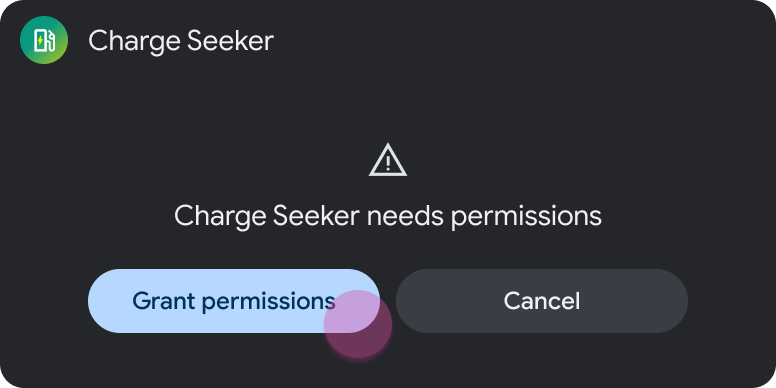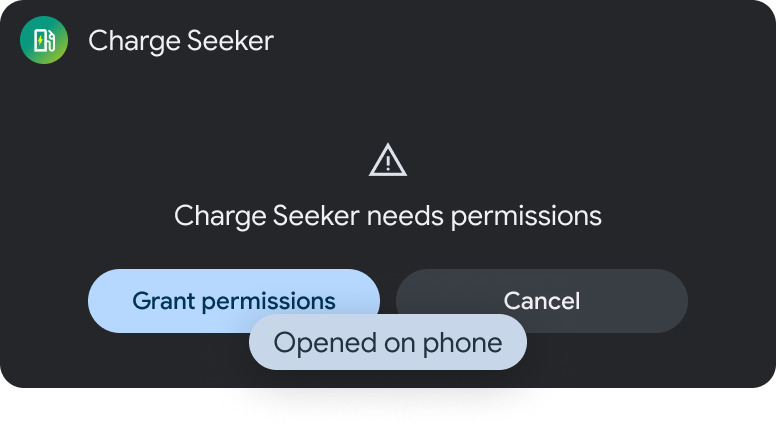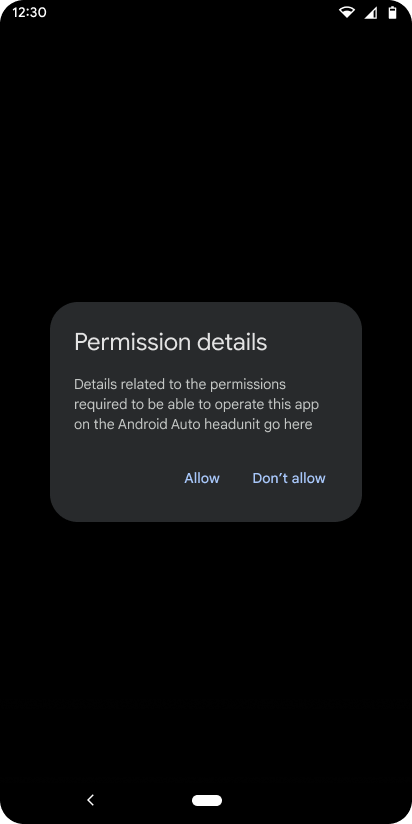যখন ব্যবহারকারীরা আপনার অ্যাপ খোলার চেষ্টা করে এবং প্রয়োজনীয় অনুমতির অভাব থাকে, তখন তাদের অনুমতি দিতে হবে তা বলার জন্য বার্তা টেমপ্লেট ব্যবহার করুন।
অ্যান্ড্রয়েড অটোতে, আপনি অনুমতির অনুরোধে বর্ণিত পদ্ধতিটি ব্যবহার করলে, ব্যবহারকারী যতক্ষণ না গাড়ি চালাচ্ছেন ততক্ষণ পর্যন্ত অনুমতি ডায়ালগ ফোনে খুলবে (প্রযুক্তিগত বিবরণের জন্য, ব্যবহারকারীর ইনপুট হ্যান্ডেল করুন)। এই ক্ষেত্রে, ফোনে ব্যবহারকারীকে নির্দেশ করে একটি টোস্ট প্রদান করুন। তারপরে, অনুমতি মঞ্জুর করার পরে, গাড়ির স্ক্রীনটি রিফ্রেশ করুন যাতে ব্যবহারকারী বার্তা টেমপ্লেটে ফিরে না আসে।
প্রথমত, অ্যাপটি গাড়ির স্ক্রিনে অনুমতির জন্য অনুরোধ করে...
...এবং তারপর ব্যবহারকারী ড্রাইভিং না করার সময় তাদের ফোনে অনুমতি নিশ্চিত করে৷
নমুনা প্রবাহ
| ব্যবহারকারীর কর্ম | যেখানে কর্ম সঞ্চালিত হয় | কর্মের পর ধাপ গণনা |
|---|---|---|
| ব্যবহারকারী অ্যাপটি খোলে। | আপনার ল্যান্ডিং টেমপ্লেটে (দেখানো হয়নি) | 1 |
| ব্যবহারকারী অ্যাপের অনুমতি দেওয়ার বিকল্পটি নির্বাচন করে, তারপর নিশ্চিতকরণ টোস্ট পর্যালোচনা করে। | প্রথমে, ব্যবহারকারীদের তাদের প্রয়োজনীয় অনুমতি দেওয়ার সুযোগ দেওয়ার জন্য দুটি বোতাম সহ বার্তা টেমপ্লেটটি ব্যবহার করুন:
তারপরে, ব্যবহারকারীকে তাদের ফোনে নির্দেশ করতে একই বার্তা টেমপ্লেটে একটি টোস্ট প্রদর্শন করুন:
| 2 |
| ব্যবহারকারী তাদের ফোনে অনুমতি দেয়। | কোনও টেমপ্লেট নেই, কারণ এই ক্রিয়াটি ব্যবহারকারীর ফোনে ঘটে:
| 2 (গাড়িতে অ্যাপের সাথে কোনো ইন্টারঅ্যাকশন নেই) |
| ব্যবহারকারীর অনুমতি দেওয়ার পরে, অ্যাপটি ল্যান্ডিং টেমপ্লেটে ফিরে আসে। | অবতরণ টেমপ্লেট; এই ক্ষেত্রে, স্থান তালিকা (নেভিগেশন) টেমপ্লেট:  | 1 (পদক্ষেপ গণনা পুনরায় সেট) |



